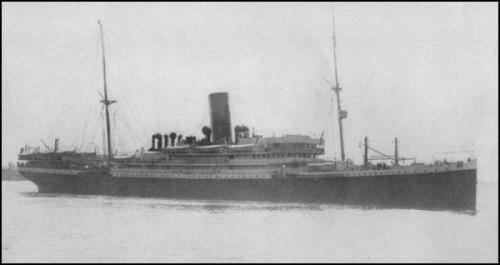Maiden voyage . Builder Workman, Clark & Co., Ltd | Launched 1908 | |
 | ||
Fate Sunk, 8 November 1915, off Cape Carbonara by U-38 | ||
SS Ancona was an Italian passenger steamer, built in 1908 by Workman, Clark & Co., Ltd., Belfast, and operated by the Society di Navigazione a Vaporetti Italia, of Genoa.
She was torpedoed and sunk without warning on 8 November 1915 by SM U-38, under the command of Kapitänleutnant Max Valentiner off Cape Carbonara at 38°14′N 10°08′E. The u-boat was flying the flag of Austria-Hungary as the German Empire was not yet at war with Italy. Over 200 lives were lost.
The Ancona incident
In November 1915 U-38 caused a diplomatic incident when she sank the Italian passenger liner Ancona off the coast of Tunisia, while sailing under the Austrian flag. The Ancona, bound from Messina to New York City, was fully booked and over 200 lives were lost, including nine Americans. Coming as it did six months after the sinking of the RMS Lusitania off Ireland, the Ancona sinking added to a growing outrage in the US over unrestricted submarine warfare, and US Secretary of State Robert Lansing despatched a sternly-worded protest to Vienna.
After receiving no satisfactory response from Austro-Hungarian Foreign Minister Baron István Burián von Rajecz, in December 1915 the US demanded that the Habsburg government denounce the sinking and punish the U-boat commander responsible. Germany, then concerned to maintain American neutrality, advised Burián to accede to the US demands, and Vienna eventually agreed to pay an indemnity and assured Washington that the U-boat commander would be punished, although this was a meaningless promise since he was a German officer. Following the settlement of the affair, the Austro-Hungarian government requested that German submarines refrain from attacking passenger vessels while flying the Austrian flag.
Burián's diplomatic accession to US demands angered Grand Admiral Anton Haus, commander of the Austro-Hungarian Navy, who had advocated taking a hard line following the sinking. Haus justified the sinking on the grounds that the Ancona could have been used on its return voyage from the US to transport armaments or Italian emigrants returning home to enlist in the Italian Army. Germany's decision in April 1916 to suspend unrestricted submarine warfare terminated the debate.
